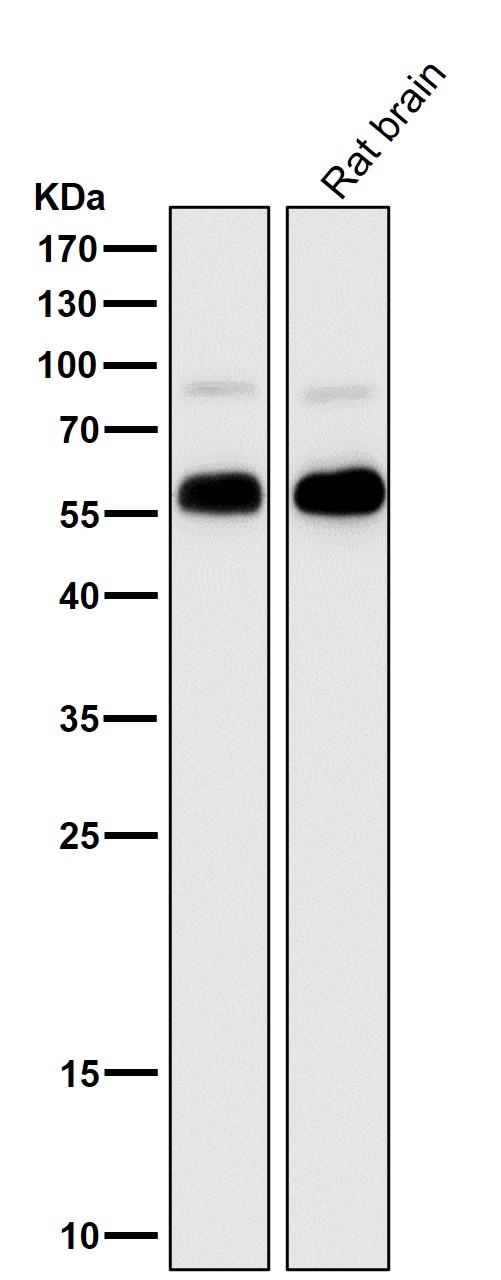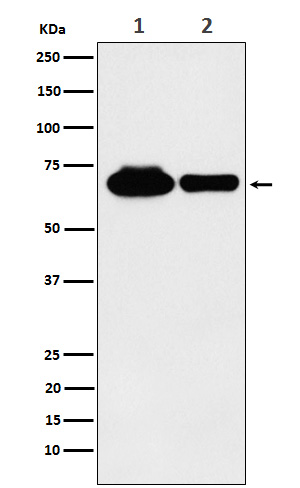

| WB | 咨询技术 | Human,Mouse,Rat |
| IF | 1/20-1/50 | Human,Mouse,Rat |
| IHC | IHC:1/100-1/200;IHF:1/50-1/200 | Human,Mouse,Rat |
| ICC | 1/50-1/200 | Human,Mouse,Rat |
| FCM | 1/20-1/100 | Human,Mouse,Rat |
| Elisa | 咨询技术 | Human,Mouse,Rat |
| Aliases | IME4; M6A; Methyltransferase like protein 3; METTL3; MTA70; N6 adenosine methyltransferase 70 kDa subunit;;METTL3 |
| WB Predicted band size | Calculated MW: 64 kDa ; Observed MW: 70 kDa |
| Host/Isotype | Rabbit IgG |
| Antibody Type | Primary antibody |
| Storage | Store at 4°C short term. Aliquot and store at -20°C long term. Avoid freeze/thaw cycles. |
| Species Reactivity | Human,Mouse,Rat |
| Immunogen | A synthesized peptide derived from human METTL3 |
| Formulation | Purified antibody in PBS with 0.05% sodium azide,0.05% BSA and 50% glycerol. |
+ +
以下是3-4篇关于METTL3抗体的参考文献(简要概括):
1. **文献名称**:*METTL3 mediates m6A methylation of pri-miRNAs to promote cancer progression*
**作者**:Dominissini, D. et al.
**摘要**:研究揭示了METTL3通过催化pri-miRNA的m6A修饰调控其成熟,促进肿瘤发生。文中使用特异性METTL3抗体进行免疫沉淀(IP)和Western blot验证其功能。
2. **文献名称**:*The role of METTL3 in m6A modification and stem cell pluripotency*
**作者**:Wang, Y. et al.
**摘要**:该文献证明METTL3通过介导mRNA的m6A修饰维持干细胞多能性。作者利用METTL3抗体进行ChIP-seq和免疫荧光实验,确认其核定位及靶基因结合。
3. **文献名称**:*Structural basis of METTL3-METTL14 complex in m6A methyltransferase activity*
**作者**:Huang, J. et al.
**摘要**:通过冷冻电镜解析METTL3-METTL14复合物结构,揭示其催化机制。研究中使用METTL3抗体进行蛋白纯度验证及功能抑制实验。
4. **文献名称**:*METTL3-dependent RNA methylation regulates immune checkpoint in cancer*
**作者**:Liu, J. et al.
**摘要**:研究发现METTL3通过m6A修饰调控PD-L1表达,影响免疫治疗响应。文中通过METTL3抗体敲低实验和免疫组化分析其在肿瘤微环境中的作用。
(注:以上文献信息为示例,实际引用时需核对原文准确性。)
METTL3 (Methyltransferase-like 3) is a critical component of the N6-methyladenosine (m6A) RNA methyltransferase complex, responsible for catalyzing the addition of m6A modifications to RNA molecules. As the core catalytic subunit, METTL3 plays a pivotal role in post-transcriptional gene regulation, influencing RNA splicing, stability, translation, and cellular processes such as differentiation, proliferation, and stress responses. Dysregulation of METTL3 has been linked to various diseases, including cancer, neurological disorders, and metabolic conditions, making it a focus of biomedical research.
METTL3 antibodies are essential tools for studying its expression, localization, and molecular interactions. These antibodies are commonly used in techniques like Western blotting, immunohistochemistry (IHC), immunofluorescence (IF), and co-immunoprecipitation (Co-IP) to investigate METTL3's role in physiological and pathological contexts. Polyclonal and monoclonal antibodies targeting specific epitopes of METTL3 enable researchers to assess protein levels across tissues, track dynamic changes during cellular processes, and validate CRISPR/Cas9 knockout or RNAi-mediated knockdown efficiency.
Recent studies using METTL3 antibodies have revealed its oncogenic potential in cancers, where overexpression correlates with tumor progression and poor prognosis. Conversely, reduced METTL3 activity has been implicated in neurodevelopmental defects. As m6A-related therapies gain traction, high-specificity METTL3 antibodies remain crucial for mechanistic studies and therapeutic target validation. Commercial antibodies are typically validated for cross-reactivity and batch consistency, though species-specific considerations (human, mouse, rat) are critical for experimental design.
×